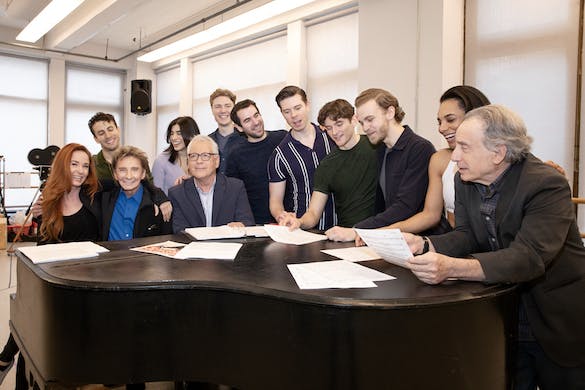They Write the Songs — This Time for the Musical ‘Harmony’
Barry Manilow is closer than ever to finally realizing one of his youthful ambitions: composing Broadway musicals.

Once upon a time, a Brooklyn boy dreamed of composing Broadway musicals. Barry Manilow got sidetracked, though — first as a jungle writer, arranger, and pianist for other artists (including a young Bette Midler), then as one of the biggest pop stars of the 1970s.
Nearly half a century on, Mr. Manilow is closer than ever to finally realizing his youthful ambitions. The National Yiddish Theatre Folksbiene production of “Harmony,” which pairs his music with a book and lyrics by longtime collaborator Bruce Sussman, opens April 14 at the Museum of Jewish Heritage at Battery Park City.
Although the venue may not be quite Times Square, the staging is helmed by a Tony Award-winning director/choreographer, Warren Carlyle — currently represented uptown by the blockbuster revival of “The Music Man” — and includes two other Broadway veterans in its cast: Chip Zien, whose many credits include the original productions of “Into the Woods” and “Falsettos,” and Sierra Boggess, whose silvery soprano and winsome presence have been featured in shows ranging from “The Phantom of the Opera” to “School of Rock.”
“Harmony” boasts the kind of ambitious storytelling that began distinguishing much of musical theater during its Golden Age. The show traces the rise and fall of the Comedian Harmonists, a German vocal group consisting of six men — three of them Jewish — who enjoyed great success in the late 1920s and early ’30s. The rise of the Third Reich made its existence increasingly untenable, and then dangerous, and ultimately forced its dissolution.
Mr. Sussman says he was inspired after watching Eberhard Fechner’s black-and-white documentary of the group at a Public Theater screening in the early ’90s: “It was such a compelling story. I called Barry from a pay phone in the street, and I said, ‘I think I’ve found the piece we’re looking for, to musicalize.’”
Mr. Manilow had previously written music and lyrics for “The Drunkard,” a musical that enjoyed 48 performances at the 13th Street Theatre off-Broadway in 1970. Years before that, as a kid growing up in Williamsburg — “when Williamsburg was a dump,” he points out — he had learned to play both Jewish folk songs and show tunes on the accordion. “I memorized the overture to ‘The Most Happy Fella’ on the accordion, and that’s a complicated score: That’s how much I loved that show, and all the others I was listening to as a teenager.”
Messrs. Manilow and Sussman also collaborated on a musical theater adaptation of the hit song “Copacabana,” staged at London’s West End in 1994; Mr. Carlyle was featured in the production, as the lead bolero dancer, and kept in touch with its creators.
“Then a few years ago, Bruce and Barry called and asked if I would consider reading or listening to ‘Harmony,’” Mr. Carlyle recalls. “I knew of it, because it has this theatrical folklore” — conceived more than two decades ago, the musical has been workshopped since, and earlier incarnations have been staged at Los Angeles’s Ahmanson Theatre and Atlanta’s Alliance Theatre — “and I just loved the book and lyrics. I found them very evocative, easy to create to. And nobody writes a melody line like Barry; he writes these long, beautiful, aching lines.”
After Covid struck, the three men wound up meeting regularly on Zoom, and the show evolved substantially. “We figured, we’ll be off for a year and a half; let’s just try something new, see if there’s another angle,” Mr. Sussman says. “And we came up with something very different.”
Mr. Zien’s character, for instance, is a new addition; an elder version of one of the Harmonists — called “Rabbi,” in a nod to his former occupation — he provides narration and reflection. (Ms. Boggess plays the younger Rabbi’s sweetheart, Mary.) Mr. Carlyle was inspired by a screen adaptation of another musical set in the same era: “Bob Fosse’s brilliant film of ‘Cabaret’ was in my head — the idea of this dark, chaotic world with beautiful art being created in the middle of it.”
Different parallels to current events have also emerged during the development and rehearsal process. With the onset of war in Ukraine, for instance, Mr. Carlyle realized that “a lot of our second act is staged with suitcases, with people running across Europe.”
As Mr. Sussman notes, though, the musical “is also about harmony, in the broadest sense of the word. These young men found harmony by being collaborators. Barry and I met 50 years ago this May 31, and what we do best is collaborate.”
Mr. Manilow agrees. “When Bruce sends me a lyric, I hear the melody before I get to the piano. We could have written three more hours of song for this show, because the story is so deep. It just moves me, the humanity of it.”

